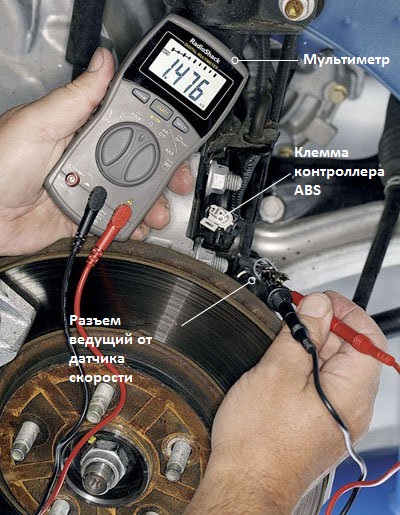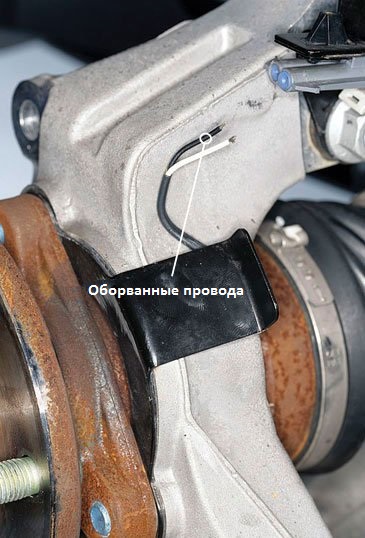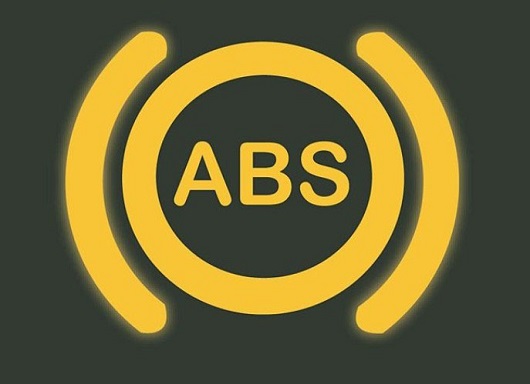ABS caught fire: brake system malfunction diagnostics
How to find out what happened to the anti-lock brake system?
Before the ABS system appears in the automotive industry in the 70s of the 20th century, cars were more dangerous. Especially when you moved along the snow-covered, icy or wet road. In those years, as a rule, old cars were equipped with not very high-quality tires, rear-wheel drive and the usual brake system without electronics. But today everything has changed. Nowadays, most of us do not even think about modern brake systems. Today we feel confident even when moving or badly got out. The fact is that most modern cars are equipped with a front-wheel drive, which gives drivers confidence driving, modern electronic security systems that control the adhesion of a car with a road surface and modern rubber, demonstrating clutch wonders with an expensive. One of the most important systems in any car is the anti-lock brake system (ABS), which significantly reduces the braking path and prevents the blocking of the wheels, which can lead to loss of adhesion with the road and accordingly.
ABS has become in the automotive industry with standard equipment, which today is installed in fact for each car produced by automotive companies. As we have repeatedly wrote the ABS system consists of a speed sensor that are installed on the wheels of the machine, from the electronic control unit of the anti-lock brake system, and the hydraulic valves, which, along the electronic block signal, are adjusted in each wheel a certain braking force without the driver's participation.
ABS wheel sensors track the speed of rotation of each vehicle wheel and constantly transmit it to the computer. As soon as the ABS block begins to see that the wheel ceases to rotate, it activates the valve of the hydraulic brake system, which reduces the brake pressure in this wheel. As a result, the pressure of the brake fluid in the wheel drops and the braking force is reduced, which contributes to the unlocking of the wheel and return the clutch with the road. This process is repeated several times per second until the car stops or the driver will not let go of the brake pedal.

The ABS control unit and the car's computer every time the ignition is turned on, the anti-lock brake system is self-test. That is, every time you start the car, the ABS automatic test occurs. If, during self-test, the computer is not enough data from the sensors, the ABS control unit and the brake hydraulic valves, the ABS warning lamp lights up. For example, if the car's computer or the ABS control unit does not receive a signal from the brake system hydraulic pump or from the valve installed on each wheel, then the ABS error will light up on the tidy (indicator).
Please note that despite the malfunction of the ABS system and the appearance of a burning ABS burn icon in your car as a rule, a mechanical braking system continues to work and you can continue to continue moving, but without an electronic helping system when braking wheels. That is, in other words, during the ABS system breakdown, you can safely use the car. True in this case, you must be extremely careful when braking on slippery, snow-covered or wet road, since without ABS system, your car can be blocked. Therefore, we do not recommend in the event of a malfunction of the ABS system for a long time to operate the machine without appropriate repair. So in case of an ABS system error, you should identify the cause of the fault and eliminate it in a short time.
ABS system malfunction

So. In your car on the dashboard, a warning lamp or an icon warn you about problems with anti-lock brake system. What to do in this case?
First, first, make sure that the fired indicator indicates the problem with the ABS system, and not a malfunction of the entire brake system.
To do this, you must carefully listen to your car during braking and pay attention to the brake pedal. If during braking you started to hear extraneous noises (whistling, knocks, screenshots, etc.) or the brake pedal became too soft (softer than usual), then your direct road to the technical center, where experts should conduct a thorough diagnosis of the entire brake Systems. Remember that these signs indicate a serious malfunction of the entire brake system. This can lead while driving to the accident. Therefore, if your car brakes have become very bad, we do not recommend leaving our common roads as it is very dangerous. In this case, call the tow truck.
Also in order to find out that the casting ABS icon caused the malfunction of the anti-lock braking system, you should also make sure that there is no air in the brake system that the brake pedal is still rigid and not too soft, and also not in the brake system. To do this, first check the level of the brake fluid, and then all brake tubes and hoses for depressurization.
In addition, turning on the ignition and seeing the ABS icon on the dashboard do not rush to panic. Maybe this is the usual error of the electronics of the car. Therefore, try turning off the ignition and remove the key from the ignition lock, and then turn on the ignition again and check the ABS icon again on the tidy again. Repeat this process several times. It is possible that this is a simple car computer error and after several ignition turns on and off. The ABS error will disappear.
If, after a few attempts on / off ignition, the ABS system error on the dashboard did not disappear you have two options:

The first option is to go to the car service where it is necessary to spend a thorough computer diagnostics of the car. The main feature of the ABS system diagnostics is an electronic ABS block survey using special equipment for possible errors in the system.
Using such diagnostics, a specialist will be able to determine the error code in the ABS system, which led to the appearance on the ABS signal icon dashboard.
Also, this error code will give a hint where exactly how to seek the cause of the ABS system malfunction.
The second option is only for those who want to get to the truth with independent forces. In order to test the ABS system without the use of expensive diagnostic equipment, a service manual is needed to your car (book on the repair and operation of your car model), a simple car tool that is sold in any automotive and a multimeter with high resistance (with high impedance). If you can not find a repair book on your car model, then look for it on the Internet and just download to your computer or on your smartphone.
Please note that in some cars you can access the diagnosis of malfunction codes stored in the computer, without using a special diagnostic scanner. To do this, you can check each electronic car unit (including the ABS control unit) using the "old" proven method: using two wires that you must connect to the appropriate electronic system connectors. For example, you can connect two wires to check the chain closure in the ABS control unit. To do this, connect the two wires to the ABS control unit connector and close the wires with a pin or clip. If after this ABS error will disappear from the dashboard, then the cause of the error in the control unit of the anti-lock brake system. Also certain contacts can be connected using a clip or pins without the use of wires.
If your machine is equipped with a modern computer, the diagnostics of the errors of which is carried out only by connecting the scanner to the diagnostic port of the OBD II (on-board diagnostic), in order to establish the cause of the ABS icon appears on the dashboard only the electronic diagnosis you can Make either in the technical center, or with the help of a purchased inexpensive error scanner on the OBD II port.

Suppose you have no time yet there is no error information in the car's computer, which led to the advent of the ABS icon dashboard. Do not rush to carry out computer diagnostics. First, check the ABS control unit fuse. After all, a frequent cause of a malfunction of the ABS system becomes the fuse of the anti-lock brake brake control unit.
And so you checked the fuse of the ABS control unit, and it turned out to be in working condition. Now what? Now you must use the multimeter to check the voltage and resistance in all electronic parts of the ABS system. To do this, familiarize yourself with the car operating and repair manual with all the appropriate control values \u200b\u200bof voltage and resistance in ABS sensors and in the ABS block itself.
True before this you must check the main harness of the wires that are connected to the ABS control unit. Carefully inspect the harness of the wires responsible for the performance of the ABS system for damage. Also pull the wire harness connector, from the ABS control unit. Inspect the contacts into the connector for contamination, oxidation, etc. All contacts must be clean. If the contacts need cleaning using a special aerosol spray to clean the electrical contacts and connectors, clean the connector from contamination.

Also, when inspecting the contacts of the ABS wiring harness connector, pay attention to corrosion of contacts. Remember that even microscopic chemicals of oxidation and corrosion can seriously increase resistance in the electrical circuit of the ABS system. So on the wires are transferred to a small voltage of electricity (millivolts), then even the slightest increase resistance due to contamination of the connector contacts can lead to incorrect operation of the entire electronic part of the ABS system. Including cause an error that will lead to lighting on the ABS display dashboard.
If the ABS system controller looks integer and is in working condition, and after disconnecting the ABS wiring harness connector from the anti-lock brake system, it did not help you solve the problem of the Burning ABS icon on the dashboard, then it's time to check the operation of the wheel speed sensors that transmit information ABS control unit. To begin with, measure the resistance of the sensors by verifying them with the control values \u200b\u200bspecified in the repair manual of your car.
If resistance within acceptable norms, then proceed to a visual inspection of the wheel rotation speed sensors, the wires of suitable to them and to the inspection of the state on each axis of the gear (or on each wheel hub), which are installed on each wheel. As a rule, such sensors belonging to mechanical sensors were installed on old cars.

Also in many modern cars at the moment sensors are used by electricity. As a rule, ABS sensors are used based on the Hall effect (inside the sensor, a semiconductor plate is installed), which interacts with the magnetic ring on the wheel hub fix the change in the magnetic field, as well as the electron formation rate on the plate into the ABS sensors.
Unfortunately, not in all cars ABS sensors and wires along which the signal from the sensors is sent to the ABS system control unit is securely protected from the aggressive external environment. As a result, ABS may fail due to damage and dirty.
In order to check the status of the wheel speed sensors and the ABS wire wires, you must first remove the wheels. For example, alternately, lifting the car to the jack from the right side.
So you will get access to sensors and wires.
If when inspecting the wiring harness of the ABS system and wheel speed sensors, you have detected damage (or the wheel speed sensor is not securely fixed or hanging out), then consider that you have found the cause of the error on the dashboard that tells you about the ABS system malfunction.
If, when inspection of wires and ABS sensors, you did not find external damage, then remove the ABS system speed sensors from the hub (or axis) and check their resistance using a multimeter (if you have not done before). Control values \u200b\u200bResistance in wheel speed sensors can be viewed in special books on repair and operating your car model.

We also advise all car owners from time to time to inspect the wheels of the ABS wheels rotation sensors even if the anti-lock brake system works properly and the ABS icon does not light up on the dashboard. The fact is that since the wires and wheels rotation sensors are located below the car, then they are constantly susceptible to the aggressive effects of the external environment. The most important enemy of wires and sensors is a salt containing in a road reagent, water and snow.

What reasons is the ABS indicator on the dashboard, if the sensors, the control unit and the ABS wires are working?

If you, tested all the electronic parts of the ABS system, found that they are in good condition, but nevertheless the ABS icon on the dashboard is still burning, most likely the problem is associated with the ABS system valve hydraulic system, which unfortunately is not subject to partial repair. .














